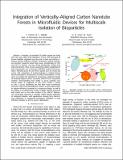Integration of vertically-aligned carbon nanotube forests in microfluidic devices for multiscale isolation of bioparticles
Author(s)
Fachin, Fabio; Wardle, Brian L.; Chen, G. D.; Toner, M.
DownloadFAchin-2010-Integration of Vertically-Aligned Carbon Nanotube.pdf (1.117Mb)
PUBLISHER_POLICY
Publisher Policy
Article is made available in accordance with the publisher's policy and may be subject to US copyright law. Please refer to the publisher's site for terms of use.
Terms of use
Metadata
Show full item recordAbstract
Presently, an estimated 35 million people are living with HIV, 300 million with Hepatitis C (HCV), with thousands of human fatalities registered ever day due to these and similar infectious diseases. Efficient, reliable, inexpensive medical solutions are therefore needed to tackle these issues. Identification of HIV and HCV is however not easy. Being significantly smaller than cells and bacteria, these viruses escape the isolation capabilities of both macroscopic and microscopic (MEMS) medical instrumentation. Allowing access to sub-micron species such as viruses and cancer cells, integration of nanotechnologies in medical devices has the potential to revolutionize the field of biomedicine. In this work, we explore the potential of nanoporous, patterned forests of vertically-aligned carbon nanotubes (VACNTs) for bioparticle isolation, demonstrating their ability to access particles over several orders of magnitude in size, from viruses (~40nm) to cells (~10μm). Modifying the flow field inside microfluidic channels, CNT-enhanced biodevices result in a seven-fold increase in capture efficiency compared to a nonporous design, as well as the ability to simultaneously isolate multiple distinct biospecies both inside and on the outer surface of the VACNT features. Our technology represents a versatile, highly efficient approach to biological isolation, with applications ranging from point-of-care diagnostics to subsequent therapeutic modalities in both infectious diseases as well as cancer applications.
Date issued
2011-01Department
Massachusetts Institute of Technology. Department of Aeronautics and AstronauticsJournal
IEEE SENSORS 2010 Conference
Publisher
Institute of Electrical and Electronics Engineers
Citation
Fachin, F. et al. “Integration of vertically-aligned carbon nanotube forests in microfluidic devices for multiscale isolation of bioparticles.” 2010 IEEE SENSORS. 47-51. ©2010 IEEE.
Version: Final published version
Other identifiers
INSPEC Accession Number: 11831714
ISBN
978-1-4244-8168-2
978-1-4244-8170-5